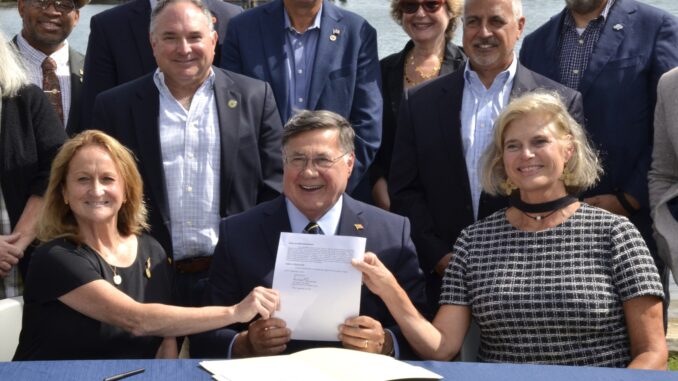
Suffolk County Legislator Catherine Stark (R-Riverhead) hosted County Executive Ed Romaine on October 1 as he signed historic legislation creating Suffolk’s ‘Working Waterfronts’ program, joined by fellow East End Legislator Ann Welker (D-Southampton), other Suffolk lawmakers and key stakeholders from the county’s fishing, aquaculture, and related marine industries.
The bill signing event was emceed by Tom Keho of Northport, a longtime leading businessman and consultant in the seafood industry whose experience extends from small to large businesses and eventually growing his own company into an international enterprise.
The year-long efforts of Stark and her colleagues resulted in the Suffolk County Legislature’s unanimous vote on September 3 for the establishment of the Working Waterfronts Program, modeled after Suffolk’s Farmland Preservation Program.
This law establishes Chapter 26 of the Suffolk County Code to establish a framework to acquire conservation easements on working waterfront properties and help forever preserve Suffolk’s commercial fishing and waterfront heritage. Unlike similar programs in a handful of states, including Maine, the Suffolk program would conserve the waterfront properties in perpetuity.
“I have long championed the preservation of farmland and open space in Suffolk County,” said Stark. “Now, Chapter 26 will give the county an invaluable tool to preserve and protect our important aquaculture and marine industries. With over 800 properties identified by a recent County study, this measure will benefit everyone from Greenport and Fishers Island all the way to Babylon and Huntington.”
Stark thanked the County Executive for his support, the stakeholders for their informed advocacy, and praised her colleagues for their unanimous agreement on a preservation not only vital to the East End, but to all of Suffolk County and its extensive waterfronts. Legislator James Mazzarella (R-Mastic), chair of the Economic Development, Planning & Housing Committee, was also on hand to attest to the bipartisan efforts behind this important legislation.
“For more than a year, I have worked with representatives from various environmental and aquaculture entities, as well as members of the Executive’s office, to clarify the critical details – the ‘fine print’ if you will — to ensure this program’s effectiveness and to encompass the many organizations and individuals in the aquaculture industry,” said Stark. “Long Island has had a long and proud marine history, and the overwhelming support which led to this bill signing demonstrates that my legislative colleagues and the County Executive are committed to protecting and preserving our working waterfronts for future generations.”
“My administration is committed to preserving our natural resources in order to protect our maritime industries,” Romaine said. “This historic legislation ensures that working waterfronts and critical coastal landmarks will be preserved from further development as we secure the future of our region’s aquaculture and the 40,000 jobs the industry employs in Suffolk County.”
The strong support shown in developing the new law was reiterated with enthusiastic attendance at the bill-signing by numerous stakeholders from working waterfronts and maritime industries.
Speaking for the commercial fishing community, Bonnie Brady, executive director of the Long Island Commercial Fishing Association (LICFA), said the program “represents a long-overdue commitment to safeguarding the essential infrastructure that sustains Suffolk County’s historic and economically vital commercial fishing industry.”
“We commend Suffolk County for being on the forefront of smart, forward-looking public policy that supports its working waterfronts. By recognizing that commercial fishing is not only a heritage industry to Long Island but also a vital contributor to state and national food security, the County Executive and Legislature is leading by example. This legislation affirms the County’s commitment to protecting maritime infrastructure and ensuring that working fishermen, who have for generations contributed to the region’s identity, economy, and fresh, wild-caught seafood supply, can continue to do so for generations to come,” said Brady.
In another statement of support, Mike and Isabel Osinski of Widow’s Hole Oyster Farm represented the aquaculture community. “We are proud that Suffolk County is acknowledging the economic benefits of the working waterfront; but also, in the case of aquaculture, our oysters clean the water, foster the growth of eel grasses, fish, and birds while providing jobs for hard-working men and women,” they said.
The law establishes a Working Waterfront Committee, composed of representatives from each township, the County Executive, the County Legislature, and the maritime sector. The chosen committee members must have some connection to aquaculture, fishing, marine industry, or related field to sit on the panel. This committee will oversee program administration, review applications from the waterfront property owners, conduct site visits, and advise on easement acquisitions and permitting. The county’s Department of Economic Development and Planning will assist the committee before recommendations are given to the legislature for approval.
The working waterfronts program will follow a process to identify and approve properties similar to the rigorous process already used by Suffolk’s successful Farmland Committee in its vigorous farmland preservation activities.

